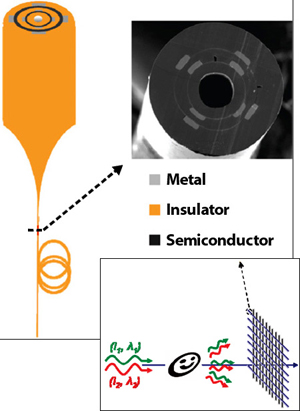 A team of researchers, led by Yoel Fink of the MIT MRSEC, has developed
A team of researchers, led by Yoel Fink of the MIT MRSEC, has developed
light-detecting fibers that can be woven together to create a flexible,
basic camera. These fibers are each less than a millimeter in diameter,
and consist of several nested layers of light-detection materials. The
fibers measure the intensity of the light illuminating them and convert
it to an electrical signal, which is then fed into a computer that
creates an algorithm to assimilate the data and create a
black-and-white image on a screen. In a recent issue of the journal
Nanoletters, the team reported that it has successfully used such a
fiber web to capture a simple image of a smiley face.
This development is significant because it is the first time that researchers in this field have demonstrated that a single plane of fibers can collect images like a camera would, but without a lens. As the research team creates more sophisticated fibers, it may be possible to weave fiber “fabrics” that can produce sharper images, even in color. A potential application could be to weave these fibers into a fabric that could be worn by a soldier, for example, along with a small screen attached to a visor, to provide increased awareness of the surrounding environment. Image: Light-sensitive detectors drawn into very thin fibers can produce images (inset) without the need for lenses. Credit: F. Sorin et al., Nano Letters, Online edition (2009) This work was supported by the Army Research Office through the ISN, the National Science Foundation through the Materials Research Science and Engineering Center Program, the Defense Advanced Research Projects Agency and the Department of Energy.